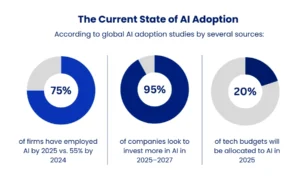In 2026, AI adoption trends and use continue to revolutionize industries at a level never seen before. Business firms in various industries, like manufacturing and retail, use artificial intelligence services to enhance decision-making capabilities, customer satisfaction levels, and process efficiencies. To innovate and maintain their competitiveness levels, firms now invest in customized AI models and services rather than experimenting without any investment. This blog examines how AI adoption changes conventional work patterns, facilitates automation, and opens up new development prospects across a variety of industries such as manufacturing, retailing, financial services, healthcare, and others.
What is Driving Business Adoption of AI?
AI is rapidly transforming the operational mode of industries; it is no longer a fictitious concept in a fictional novel. The recent AI adoption trends and uses indicate exponential growth supported by tremendous investments, new findings, and the increasing number of qualified specialists. It is also expected that AI adoption will increase to $638 billion by the year 2034. The world of business is evolving with convergence among intelligent systems of all types of AI, such as production, medicine, finance, retailing, and even cybersecurity.
The adoption rate and scale are unparalleled today. Intelligent agents, generative AI, neural networks, and human-robot collaboration are examples of innovations that are no longer limited to experimental labs but are producing quantifiable benefits in real-world applications.
Custom AI models and services are being used by companies of all sizes, from start-ups to multinational corporations. This is to replace antiquated procedures with more intelligent, automated, and predictive systems. Key examples of AI adoption trends include:
- AI-powered chatbots and agents for customer care are two important examples. By responding to standard and even complicated client inquiries, human teams can reduce their effort.
- Predictive analytics-based demand forecasting: AI analyzes historical sales data, seasonal trends, and market swings to optimize inventory and planning.
- Predictive maintenance programs driven by AI monitor machine operation in real time, spot anomalies, and prevent unanticipated breakdowns or accidents.
Industries are putting AI into practice in real-world use cases that boost efficiency, cut expenses, and spur creativity on a large scale as its adoption picks up speed.
Top 7 AI Adoption Trends That Will Revolutionize Industries
Artificial intelligence is quickly changing, and adoption trends will change how companies conduct business in every sector. Smarter technology is being utilized across industries to facilitate innovation, decrease costs, and provide a competitive edge, spanning from manufacturing-based AI to retail-based eCommerce-based AI. The following is a compilation of the most important AI adoption trends having maximum impact:
AI Democratization: Spurring innovation within every firm
Artificial intelligence no longer concerns technology firms alone. Smaller companies can avail customized services of AI without large investments in infrastructure due to readily available tools, open models such as LLaMA, and inexpensive APIs.
Small businesses and new startups could produce professional websites using AI site builders without prior knowledge of any code. To enhance performance and boost customer conversion, AI-driven personalization engines can be used to tailor marketing messaging, product recommendations, and content based on customers. This is a big leap in ensuring that all companies, irrespective of their size, can access AI-powered services.
Multimodal AI Models: Audio, Video, Pictures, and Text
One of the trends is the ability of multimodal AI models to process various types of content within the same framework without difficulty. These models render new experiences: the healthcare tools generate reports based on X-rays that appear in natural language, and the education systems merge text and interactive video explanations.
Multimodal models will enhance quality checks and predictive maintenance by integrating visual diagnostics with real-time data analytics, enhancing productivity and reducing downtime.
Ethical and regulatory AI are emerging as significant
Questions such as deepfakes, data privacy, and copyright violations have become essential with the spread of AI adoption patterns and services increasing rapidly. New regulations, such as the EU AI Act and US laws on data protection, will affect how companies adopt AI adoption trends.
To guarantee compliance, organizations are actively creating ethical AI committees, including watermarking techniques, and working with legal professionals. This ethical strategy upholds consumer confidence and complies with international regulations while promoting the safe deployment of AI.
Smaller AI Models for Flexible and Economical Processes
Conventional large-scale models require a lot of processing power. Businesses are moving toward specialized AI models made to function well on edge networks and mobile devices to address this.
These models are perfect for wearable technology, embedded systems in manufacturing, and AI in retail and e-commerce. This is because they provide quicker reaction times, reduced operating costs, and improved privacy. Additionally, they provide quicker deployment and lessen dependency on bulky GPU hardware.
Overcoming Hardware Limitations through Creative Implementations
AI adoption trends are scalable and being hampered by a hardware constraint brought on by the growing demand for GPUs. To maximize performance without overtaxing resources, businesses and AI development firms are reacting with hybrid infrastructure techniques that include CPUs and TPUs.
AI systems may function effectively even on mobile devices and in sectors where lightweight deployment is essential, thanks to techniques like quantization and pruning, which further reduce model sizes.
Growing Interest in Human-Robot Collaboration (CoBots)
The future will see an increase in human-robot cooperation, particularly AI adoption trends in industries like agriculture and health care. Robotic-assisted surgery, autonomous bots that are simplifying crop-harvesting, and AI-controlled exoskeletons are already assisting workers in laborious tasks.
These developments can help businesses become more productive, reduce the number of injuries to workers, and bridge the knowledge gap between automation and human experience.
Applying Corporate Governance to Shadow AI
One of the most used AI adoption trends for employees is to use unapproved AI technologies, or “shadow AI,” which presents increasing hazards to data compliance and integrity. In order to properly handle this problem, organizations are already developing governance frameworks.
Businesses make sure that custom AI services are safe, legal, and in line with corporate goals by implementing permitted platforms, keeping an eye on tool usage, and doing frequent integration audits.

How Can AI Adoption Drive Intelligent Growth for Businesses
Artificial intelligence is transforming industries of all kinds through its creative applications that contribute to productivity, security, and customer satisfaction. According to the latest AI adoption trends, industries like manufacturing and retail, banking, and healthcare are using customized AI models and services to gain a competitive edge.
Increasing Detection and Prevention of Cybersecurity
AI has developed to be a primary component of current-day cybersecurity as it allows businesses to identify malware, phishing, and suspicious network traffic. Threat intelligence and real-time anomaly detection can help organizations mobilize autonomous defenses that can react in real-time to newly emerging threats.
Application security development is the other area where AI is essential since the software can detect bugs before it is too late, as well as guard against leaked information at an early stage. The risks of cyberattacks are reduced by such developments and AI adoption trends to create stable, future-proof technologies.
Healthcare: Changing Patient Care, Diagnosis, and Treatment
In the healthcare industry, artificial intelligence services are improving imaging diagnostics, faster medication discovery, and more personalized patient care. Virtual assistants provide post-operative care and guidance, and AI-based imaging technologies can detect cancers before human examination.
The developments optimize patient outcomes, minimize operational time wastage, and improve the precision of treatment. AI adoption trends are driving the uptake of decision support systems in hospitals as an effort to streamline operations and improve treatment efficacy.
Education: Personalizing Instruction and Computerizing Management
AI is being utilized by the education industry to enhance administrative effectiveness and create personalized learning plans. These AI adoption trends include systems grade, track attendance, and track performance metrics with minimal human input, while adaptive learning solutions. Moreover, custom AI models can modify curriculum material in real time according to student performance.
In addition, conventional classrooms are being converted into interactive, immersive environments that enhance engagement and retention using AR and computer vision-based technology.
Manufacturing: Improving Production and Control
Manufacturing lines are also being transformed by AI adoption trends to use real-time inventory control, visual monitoring, and predictive maintenance, among others. As AI-based robots scan supply chains to lower stockouts, smart sensors scan equipment health to prevent failures.
These tailored AI services allow manufacturers to minimize downtimes, waste, and maintain the quality of products.
Science and Research: Improving Discovery and Innovation
Since AI adoption trends are capable of simulating complex systems, including fluid dynamics, climate models, and material breakthroughs, it has emerged as an important tool in scientific research. There are already quantum-enhanced AI applications that are enabling scientific use to analyze large data sets more efficiently, resulting in advances in physics, chemistry, and astronomy.
Due to such an increased invention rate, research institutes can introduce game-changing technologies much faster.
Business Operations: Automation and Improved Decision-Making
Companies across different industries have been engaging an AI development company to enhance decision-making and shorten the process. Chatbots retain clients more by providing 24/7 support, whereas AI-based dashboards provide financial and logistical predictive insights.
Employees will now be able to work on priority growth initiatives with more automation of the day-to-day accounting and HR functions.
Banking and Finance: Reaching New Security and Efficiency Levels
Financial organizations are quickly adopting AI to increase efficiency, identify irregularities, and automate repetitive processes like processing payments and reviewing mortgages. Real-time user activity monitoring by AI-powered authentication systems improves security.
Robo-advisors for portfolio management, algorithmic trading for higher returns, and AI-based fraud detection to protect assets are examples of emerging application cases. These developments put the industry in a position to create significant value while following changing governance rules.
Retail and e-commerce: Customizing Purchases and Cutting Down on Fraud
AI adoption trends in e-commerce and retail are ushering in a new era of interaction between companies and their clients. Retailers are using AI chatbots to boost their conversion rates, specifically at high times such as the holidays. Innovative fraud tracking tools, artificial intelligence-based inventory management, and hyper-personalized shopping experiences are becoming the norm in the industry.
The presence of AI-based voice and visual search tools leads to products being easier to locate, which leads to more pleasant shopping experiences and an increase in customer satisfaction.
Conclusion
AI adoption is a current catalyst for industrial transformation rather than a futuristic idea. Businesses are incorporating custom AI services to streamline operations, enhance consumer engagement, and build more intelligent decision-making ecosystems, from AI in manufacturing to AI in retail and e-commerce.
With solutions created to meet their specific needs, we at AnavClouds Analytics.ai assist businesses in leveraging AI adoption trends. We give your company the tools it needs to stay ahead, whether that means intelligent automation, custom AI models, or full-service AI. Set up a consultation for free right now!
Frequently Asked Questions
What is the greatest challenge to the use of AI?
Ethical and regulatory issues present one of the greatest challenges in the implementation of AI. Most AI systems have the potential to support biases unintentionally, resulting in discriminatory or unfair results. To create responsible AI solutions, organizations should apply stringent compliance policies, transparent algorithms, and bias-free training data.
What can businesses do to overcome AI resistance?
The most common resistance is associated with ignorance or fear of losing a job. One way companies can solve it is to educate teams about how AI can supplement, rather than substitute, human work, and roll out AI tools with quantifiable value over time.
What industries are the most benefiting industries of AI?
Although AI is transforming nearly all sectors, healthcare, financial, manufacturing, retail, and logistics are undergoing the greatest change. These sectors use AI to automate, perform predictive analytics, create a personalised experience, and optimize processes.
Is AI costly to small and medium businesses?
Not necessarily. The price of AI implementation is based on the project size and complexity. There are numerous cloud-based AI systems and SaaS applications that allow SMBs to adopt AI without significant initial investments.
What are the implications of AI adoption trends on business in the long term?
Adoption of AI leads to efficiency, decision-making, and creation of new sources of revenue. Organisations that embrace AI technologies early find themselves at a competitive advantage due to their ability to provide quicker, more customised, and data-informed services.



